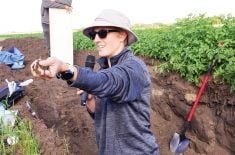Many nutritional experts believe nitrogen and phosphorus and a range of greenhouse gases can be significantly cut out of livestock production.
That would remove an environmental knife at the throat of livestock producers.
“If it is applied across the board, you will see a marked reduction of phosphorus and nitrogen, both in ruminants and monogastrics,” said University of Manitoba researcher Ermias Kebreab in an interview during the Western Nutrition Conference.
“It’s a big difference.”
Kebreab and other researchers at the conference presented papers outlining various feeding methods and feed ingredients that could much reduce unwanted nutrients in animal urine and fecal matter.
Read Also

Soybean market still figuring out implications of China-U.S. pact
Soybean futures had a muted reaction to the U.S. trade deal with China as the market tries to figure out the nuances of the deal.
Kebreab and fellow University of Manitoba researchers have shown that phytase added to pig diets can reduce the addition of inorganic phosphorus to the grower-finisher animal’s diet to 55 to 60 grams from 300 grams. And no inorganic phosphorus needs to be added after the animal is 10 weeks old.
Almost every presentation at the conference referred to the concern about pollution from livestock production.
Chris Reynolds of the University of Reading in England said a wide-ranging approach could bring tangible results.
“This suggests that the adoption of ‘best practice’ in feeding and management of cattle for milk and beef production will be as important as new technologies and dietary supplements for future increases in energy efficiency and reductions in (greenhouse gas) emissions attributable to milk and beef production systems,” said Reynolds.
Jean-Yves Dourmad of Saint-Gilles, France, said emission of pollutants from pig farms and use of non-renewable resources should be reduced as much as possible.
Improving nutrient availability in feeds will reduce the need for supplementation, he said, and more intense management of animals, such as two- and multi-phase feeding, will allow diets to be customized so little waste occurs.
“Compared to the one-phase feeding strategy, the two-phase and the multiphase feeding strategies reduced consumption and excretion (of phosphorus),” said Dourmad.
Karen Koenig of Agriculture Canada’s research centre in Lethbridge, noted that biofuel feed byproducts can carry greater environmental impacts than feedlot operators expect.
“Distillers’ grains and other by-product feeds can provide an economical source of energy in feedlot diets, but it will be important to limit their inclusion in the diet to avoid overfeeding (nitrogen) and other nutrients, and the potential associated environmental impact,” said Koenig in her conclusion.
Kebreab said researchers are becoming increasingly confident that many methods of nutrient management and formulation will allow livestock production to slash the amount of nutrients that flow out of their animals in urine and manure.















